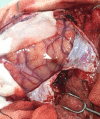Fulminant and Diffuse Cerebral Toxoplasmosis as the First Manifestation of HIV Infection: A Case Presentation and Review of the Literature
- PMID: 31982888
- PMCID: PMC6998800
- DOI: 10.12659/AJCR.919624
Fulminant and Diffuse Cerebral Toxoplasmosis as the First Manifestation of HIV Infection: A Case Presentation and Review of the Literature
Abstract
BACKGROUND One of the most common causes of central nervous system (CNS) opportunistic infections in immunocompromised patients is toxoplasmosis. It can cause focal or disseminated brain lesions leading to neurological deficit, coma, and death. Prompt management with optimal antibiotics is vital. However, the diagnosis of cerebral toxoplasmosis is challenging in infected individuals with human immunodeficiency virus (HIV). The possible diagnosis is based on clinical presentation, imaging, and specific serologic investigations. The diagnosis can be confirmed by histopathological examination and/or by finding nucleic material in the spinal cerebrospinal fluid (CSF) examination. CASE REPORT We present a review of the literature with a rare illustrative case of diffuse CNS toxoplasmosis as the first manifestation of HIV infection in a young patient. Brain MRI showed diffuse, ring-enhancing lesions, and significant midline shift. Decompressive hemicraniectomy for control of intracranial pressure and anti-infectious therapy were performed. CONCLUSIONS This should raise awareness that cerebral toxoplasmosis can occur in pediatric patients with HIV infection, and, more importantly, as the first manifestation of AIDS. Although the prognosis is often poor, early diagnosis and immediate treatment of this life-threatening opportunistic infection can improve outcomes.
Conflict of interest statement
None.
Figures



References
-
- Murray PR, Rosenthal KS, Pfaller MA. Medical microbiology : Elsevier Health Sciences. 2015
-
- Benson CA, Kaplan JE, Masur H, et al. Treating opportunistic infections among HIV-infected adults and adolescents : Recommendations from CDC, the National Institutes of Health, and the HIV Medicine Association/Infectious Diseases Society of America. Clin Infect Dis. 2005;40(Suppl. 3):S131–235.
-
- Pistacchi M, Gioulis M, Zirillo M, et al. Cerebral toxoplasmosis in undifferentiated connective disease treated with mycophenolate mofetil : An unusual case report. Acta Neurol Belg. 2016;116(4):633–36. - PubMed
Publication types
MeSH terms
LinkOut - more resources
Full Text Sources
Medical

